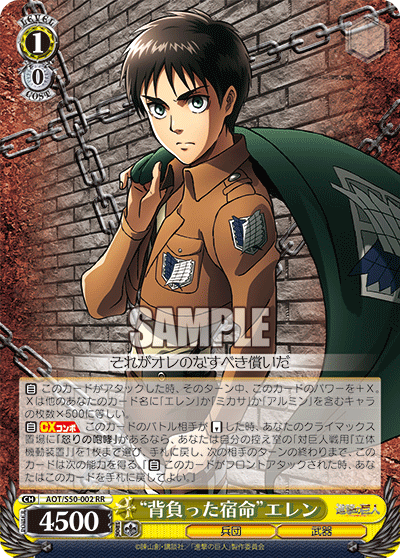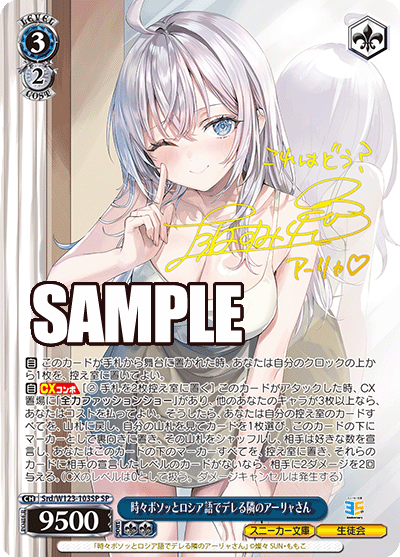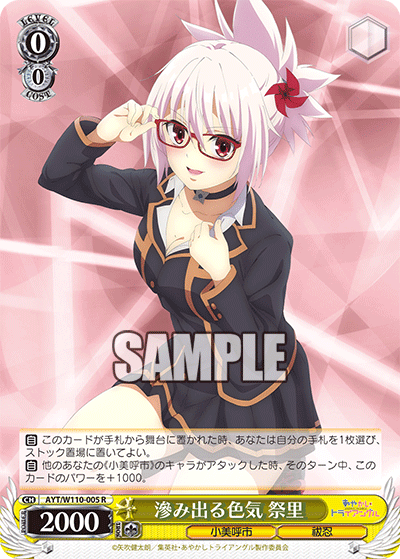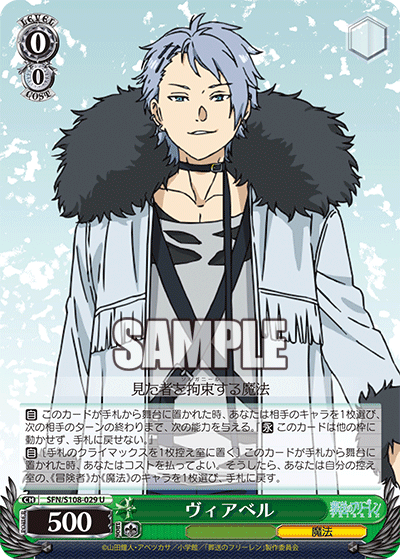So let’s go through a time lapse. Imagine it is late 2017, and you’ve heard the announcement and supports for one of the most hip anime series at that time, Attack on Titan. There’s also the birth of a combo that was relatively new on its conception with few clone copies in other sets. This combo came to define the game, and for many who were still reliant on reverse combos at that time, this series was an absolute nightmare to deal with.

He’s here and he’s so back. So indeed, Eren does need to reverse to activate his combo, but Eren himself prototypes what would eventually be given the profile name of the Oboro combo. For a simple breakdown, an Oboro combo essentially grants itself the ability to bounce back to hand upon being fronted during your opponent’s turn.
Now Eren was quite innovative in his time for two reasons: people were still mainly dependent on reverse combos and the fact that Eren gave you both an advantage in the card he salvaged and another hand in the form of itself during your opponent’s turn. While advantage combos typically give you one extra hand, Eren supplied you two in total. Furthermore, even if you were at hand limit during your turn, Eren bounces back on your opponent’s turn, letting you go overhand into your next turn should your opponent front him. They would also be heavily incentivized to do so or would have to side and potentially lose out on damage.

Overtime, Oboro combos have become less common and are considered to be generally weaker combos. The reason for this is obvious. Most modern day Oboro combos do not give you additional hand like Eren did. Granted, Eren did have a condition to give you extra hand. Most Oboro combos nowadays do not require reverse at all, making the reliance on your opponent’s board less of a hindrance. In exchange, most modern Oboro combos fail to provide any additional advantage nor push you closer to finding your pieces for the end game.



APO/S53-064SP-SP “差し出す手”黒のライダー (center)
DC3/WE40-10N 優美な天才美少女 リッカ (right)
Nowadays, finding an Oboro combo in a modern set that provides you more than just its returning ability is rather rare. Although, personally, I think that’s a good thing. Now before you raise the torches, let me just explain that the reason I would be inclined to agree that Oboro combos that provide additional advantage should not appear again. So back in 2015 when Eren first appeared, Eren was phenomenal and great. He got you the advantage you wanted and more. And into the late game, you’d be given a larger amount of resources compared to the typical player presuming you were able to loop his combo. With that advantage, you could more consistently tri-field out a finisher such as Mikasa and then proceed to do her burn and swing.


Srd/W123-103SP-SP 時々ボソッとロシア語でデレる隣のアーリャさん (right)
The problem is now we are in 2025. Finishers don’t often just do a single finishing ability followed by a swing. Some of the most powerful finishers are simply held back by the lack of available resource generators. With Oboros that provide that additional resource and maintain hand, these finishers would become much more common and an annoyance to deal with. Furthermore, even decks that don’t have costly finishers would more than readily take the combo that gives them twice the hand or extra hand and stock.



NIK/S117-T02R-RRR “ピンポイントミサイル”アニス (center)
AYT/W110-005R 滲み出る色気 祭里 (right)
While extra stock is obvious for what it can do, especially in the late game, extra hand, even if random, can be easily recycled thanks to the plethora of different profiles that exist in the modern game. Extra resource can just as easily be converted into something you need or be turned into additional resource in another capacity. While in Eren’s time, these profiles were generally considered rare, making the extra hand mainly be for compression purposes. Furthermore, in the modern game, it is much easier to grab a climax to make it essentially free for you to loop your Oboro combo with a bit of nuance.

One of the other major nuisances that exist with Oboro combos is the fact that they trivialize combat. With Oboro, there is essentially no battle step comparisons needed to be made. Since the opposing player can simply choose to bounce back to hand when fronted, no reverses will theoretically ever take place. Oboro essentially sets the precedence of solitaire-based gameplay where the player needs to care for little outside of making sure their Oboro survives cross-turn with its combo intact. This heavily dulls gameplay as many profiles that are contingent on a reverse ability are essentially made moot. Consider that even when fronted and bouncing back to hand, these combos also were technically on the field, allowing you to reduce damage taken even when they were returning to your hand.
Add that to the fact that Oboro combos are essentially untouchable outside of a few very specific effects. Flickering nullifies the combo as the Oboro combo returns as a new card, losing its previous ability tied to its combo. But in general, the cards that provide effects like flickering are rather niche. Outside of specific builds and flex slots, they are not very efficient to run, and it’s generally not worth it to constantly keep cards in for a singular rather obscure match-up.
In conclusion, due to the overwhelming advantage that came with Oboro combos providing you extra advantage in its plussing ability (if it had any) and itself, nullifying reverse effects, and being virtually unable to be interacted with, it doesn’t seem strange to me that Oboro combos have been phasing out in modern series. Given the nature and the speed of the modern game, and the ease in transforming advantage into other forms, it doesn’t come as a surprise to me to see Oboro combos being much more reduced in power compared to their older versions.